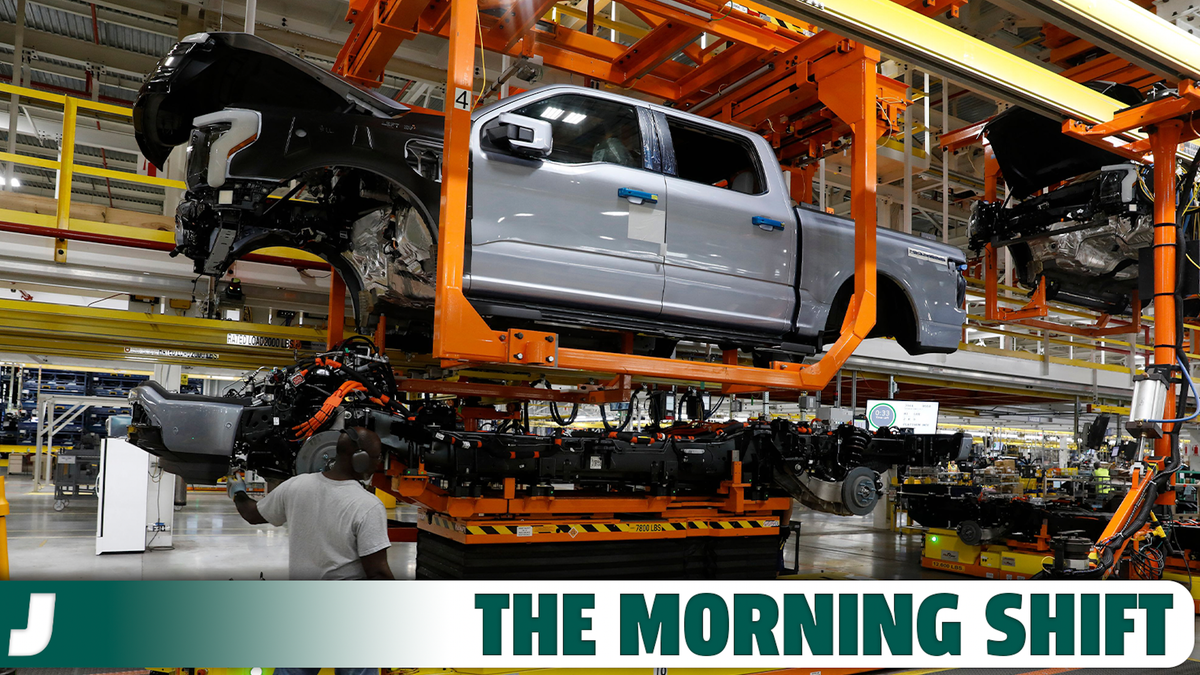Good morning! It’s Thursday, October 31, 2024, and this is The Morning Shift, your daily roundup of the top automotive headlines from around the world, in one place. Here are the important stories you need to know.
1st Gear: F-150 Lightning Plant To Idle In Mid-November
We’re starting off with some bad news for Ford. The Blue Oval says it plans to stop building the electric F-150 Lightning pickup truck from mid-November through the end of the year. The automaker is pointing the finger at lower-than-expected demand for the decision.
The seven-week shutdown is slated to start at the end of the day on November 15. It’ll encompass the traditional week-long holiday break, and production will restart again on January 6 (if Mike Pence has the courage.) The news got out when Ford notified suppliers and plant officials of the plan. From Automotive News:
“We continue to adjust production for an optimal mix of sales growth and profitability,” Ford said in a statement.
The extended hiatus in Lightning output marks the latest downshift for a once-hot product whose importance CEO Jim Farley and Executive Chair Bill Ford have likened to that of the Model T.
Ford started the year by cutting in half planned Lightning production targets and slashing two-thirds of the jobs at the Rouge Electric Vehicle Center in Dearborn, Mich., dropping it to one daily shift. In early 2024, a stop-ship order for an undisclosed quality issue halted shipments of the truck for more than nine weeks, although production continued.
Sales of the F-150 Lightning are actually up 86 percent to 22,807 trucks this year through September. That may sound pretty good, and it is, but it also means the Lightning lost its title as the U.S.’s best-selling electric pickup to the Tesla Cybertruck.
Cox Automotive said Ford had a 100-day supply of F-150s at the end of September, although it did not provide an estimate specifically for the Lightning. The automaker entered October with 130 days’ worth of the Mustang Mach-E and enough E-Transit vans to last 128 days, Cox said.
Farley, on Ford’s Oct. 28 third-quarter earnings call, cited the “slow uptake of EVs” as a challenge but said he was pleased with the strength of Ford’s overall electric vehicle strategy, “which I wouldn’t trade for any of our competitors.”
The automaker has pivoted its focus away from larger EVs to a low-cost platform that will first underpin a midsize pickup in 2027. Ford last year said it would delay about $12 billion in EV spending and has pushed back the production timeline for a next-generation full-size electric pickup.
Farley, on the earnings call, said the company has reduced EV costs by $1 billion this year and trimmed capacity by 35 percent.
[…]
Farley said Ford expects to “improve the trajectory of Model e’s business through cost scaling” in 2025, although it has not yet provided financial guidance. Morgan Stanley analyst Adam Jonas, in an Oct. 29 investor note, estimated Ford’s EV loss would shrink to $4.4 billion in 2025.
Ford was able to reduce the losses it suffered from its Model e EV business in the third quarter to $1.2 billion. However, it still expects the unit to lose about $5 billion in 2024. Ouch.
2nd Gear: VW Plans To Cut Workers’ Pay By 10 Percent
Volkswagen says it needs to quickly cut costs after reporting dismal third-quarter earnings. It’s blaming a rough economic environment, disappointing demand for EVs, strong competition from Chinese automakers and a costly domestic manufacturing footprint for the downturn.
During talks with labor representatives, VW pitched a plan to cut workers’ pay by 10 percent. On its face, that’s not going to go over well, but it gets even worse when you realize the union has been asking for a raise. It’s a real mess. From the Wall Street Journal:
Earlier this week, Volkswagen’s top labor leader said the company was aiming to shut at least three factories in Germany, lay off tens of thousands of staff and cut worker’s wages by 10% as part of a cost-cutting drive.
[VW CFO Arno] Antlitz said Wednesday that Volkswagen needed to find a compromise that shrinks its cost base while also allowing the company to invest in new vehicles and boost its profit margin. Rising energy, materials and personnel costs mean some of Volkswagen’s German plants are twice as expensive as its competitors, the company has said.
“I’m confident that we’ll reach an agreement…but of course, I cannot rule out strikes,” Antlitz said.
Worker groups have vowed to fight any plant closures in Germany, which would be the first in the company’s history.
The comments came after the company, which also houses the Audi and Porsche brands, reported a 7.1% drop in third-quarter car deliveries on year. Deliveries in China fell 15%.
Here’s how Volkswagen’s third quarter went overall. Spoiler: it wasn’t good:
Volkswagen said third-quarter after-tax profit fell 64% to 1.58 billion euros, equivalent to around $1.71 billion. Revenue fell 0.5% to 78.48 billion euros. Both measures slightly beat analyst forecasts.
The company’s operating margin for the quarter fell to 3.6% from 6.2%. Restructuring costs, higher fixed costs and expenses related to new products have all hit profitability so far this year, it said.
The namesake Volkswagen brand reported an operating margin of just 2% in the year to date. “This highlights the urgent need for significant cost reductions and efficiency gains,” Antlitz said.
[…]
Volkswagen last month slashed its sales and profitability forecasts for the full year, expecting sales of around 320 billion euros in 2024 compared with 322.3 billion euros last year. It expects to deliver about 9 million vehicles this year, below the 9.24 million units delivered in 2023, and now forecasts a full-year operating margin of 5.6%.
VW says it expects the fourth quarter to be a bit more solid, driven by higher volumes and better sales on its more profitable cars. It really needs it.
3rd Gear: Fain Says UAW To Save Stellantis ‘From Itself’
United Auto Workers union members rallied on October 30 in Detroit over Stellantis’ investment commitments to the east side of the city. UAW President Shawn Fain, a staunch critic of Stellantis CEO Carlos Tavares, told the crowd, “It’s up to the membership to save the company from itself.” He made the comments as layoffs and furloughs become a big problem for the UAW at the automaker. From the Detroit Free Press:
The job cuts represent just one of the issues at the automaker that owns the Jeep, Ram, Chrysler, Dodge and Fiat brands. The company has struggled to manage inventory, has seen its sales drop in the United States, and is fighting with the UAW, suppliers, dealers and even shareholders. CEO Carlos Tavares has also announced plans to retire in 2026.
[…]
He accused Stellantis of trying to intimidate union members as they weigh potential strike authorization votes as part of a threatened national strike with robocalls and emails. He called out Tavares for the company’s stated plans to shift work to low-cost countries and said the company’s cost-cutting is a “pathway to a dead end.”
Despite the issues that Stellantis faces, he asserted that “a strike will cripple this company,” and that the company is scared, which is why it is fighting hard to prevent one.
olkswThe union has hosted similar rallies in the last couple of months in Trenton, Warren and Sterling Heights, and several locals have passed strike authorization votes as the union has threatened a potential strike. Three have voted in favor, but this week, Local 1166 in Kokomo, Indiana, failed to get the necessary two-thirds vote in favor of strike authorization.
Kevin Gotinsky, who heads the UAW’s Stellantis Department, described the Local 1166 vote as a low-turnout election, with about 61% voting in favor. He said the union is confident it can get “everybody moving together” going forward, with a more aligned approach over the next three months.
Of course, strike authorization doesn’t guarantee that a strike will happen, but you can rest assured that Stellantis doesn’t want the UAW to have that sort of leverage over it.
Here’s what Stellantis said of the rally and the situation it finds itself in with the union:
Stellantis […] said the contract with the union ”clearly states that all planned investments are subject to business factor contingencies including market conditions and consumer demand, and company approval. The investments and timelines are not absolute guarantees.”
The statement noted, “There is indisputable volatility in the market, especially as the industry transitions to an electrified future. Over the past year, numerous companies across the industry have announced investment and product delays as well as outright product cancelations. This is information that the company has repeatedly shared with the UAW and that they have acknowledged.”
This could get real messy, folks.
4th Gear: Carvana Is Having A Really Good 2024
Carvana just posted a net income of $148 million for the third quarter of 2024. That number represents gains over the first two quarters of the year, but it’s still down 80 percent from the $741 million it reported in Q3 of 2023. Of course, that number comes with an asterisk because a gain on debt reduction enabled it.
The Tempe, Arizona-based online used car retailer sold 108,651 vehicles in the third quarter. That’s up 34 percent from the same time a year ago. It was also up 7.1 percent from the second quarter of this year. From Automotive News:
Net income: $148 million, down 80 percent from the same time last year and up 208 percent from the previous quarter. Carvana’s reported net income of $741 million in the third quarter of 2023 factored in a one-time gain of $878 million on debt reduction.
Revenue: $3.7 billion, up 32 percent year over year.
Vehicle sales: 108,651 used vehicles, up 34 percent year over year.
Operating income: $337 million, up 602 percent year-over-year and a record for the company.
Total gross profit per vehicle: $7,427, up 25 percent year-over-year.
Retail gross profit per vehicle: $3,497, up 30 percent year-over-year. Carvana in a letter to shareholders said growth in third-quarter retail gross profit per vehicle was primarily driven by higher spreads between wholesale and retail market prices, lower retail depreciation rates, lower average days to sale and reductions in reconditioning and inbound transport costs.
Adjusted EBITDA: Carvana reported $429 million in adjusted earnings before interest, taxes, depreciation and amortization, above analysts’ expectations of $326.8 million, Bloomberg reported. Revenue also surpassed consensus estimates of $3.46 billion.
Looking toward the fourth quarter, Carvana expects its positive trend to continue. Its year-over-year growth rate in retail vehicles sold is set to increase once again in Q4. This is really quite the turnaround from where Carvana was just a few years ago.






